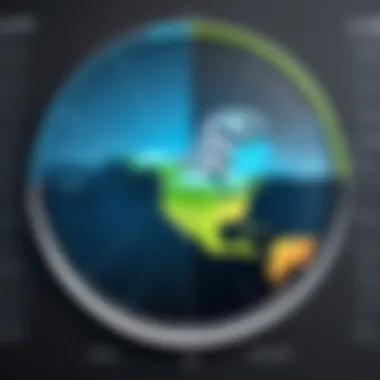Is Climate Change a Real Thing? An In-Depth Examination


Intro
In recent years, climate change has transformed from a hushed concern in boardrooms and coffee shops into a roaring elephant in the room. For many, it raises a burning question: Is climate change a real phenomenon or merely a throwaway topic debated by philosophers and environmentalists alike?
Understanding climate change involves much more than just graphs and statistics made by scientists holed up in labs. It penetrates our daily lives, influencing everything from the crops we eat to the air we breathe. The discussion can feel overwhelming, with mountains of research and data to sift through. Still, there’s a pressing need for a grounded conversation around this critical subject.
As we dive into the complexities of whether climate change is fact or fiction, we will explore the implications it holds across various sectors—economic, social, and political. The aim is to offer a layered examination that challenges stereotypes and unravels common myths. In doing so, readers will be encouraged to confront their preconceptions and actively engage with the ongoing discourse surrounding this pressing global challenge.
Understanding Climate Change
Understanding climate change is crucial, especially in the era we live in today where information overload can muddle public perception. As technology advances, so does our ability to analyze complex data surrounding this serious issue. Without grasping the fundamentals of climate change, individuals can miss important cues about our environment's future and their role within it. Knowledge on this subject flows not just from scientific circles but also from global cultural shifts, policy changes, and personal anecdotes.
When discussing the elements that constitute climate change, it is clear the ramifications extend beyond just rising temperatures. They include unpredictable weather patterns, sea-level rise, and shifts in biodiversity, among other factors. A firm grasp enables individuals within tech-savvy and innovative communities to data-analyze trends, contribute solutions, and advocate for necessary changes.
Definition and Scope
Climate change refers to significant and lasting changes in the Earth's climate—in particular, those that occur over an extended period. While natural climate variations exist, scientific consensus emphasizes that human activities, particularly the release of greenhouse gases, are fundamentally altering these patterns. The two main components driving climate change stem from the influence of these gases and the resulting impact on atmospheric temperatures, making it essential to clearly differentiate between natural fluctuations and human-induced shifts.
The scope of climate change encompasses various domains:
- Atmospheric: Changes in the composition of the atmosphere due to greenhouse gases.
- Ecological: Impact on ecosystems and species, pushing some to adapt and forcing others to extinction.
- Social: How communities, especially those vulnerable, face challenges, particularly in responding to climate impacts.
Historical Context
To fully appreciate today’s climate challenges, examining historical patterns is important. For instance, the Industrial Revolution sparked significant increases in fossil fuel use, escalating greenhouse gas emissions. Before that, Earth's climate had undergone cycles of warming and cooling, but none as dramatic or rapid as the changes we've seen since the mid-20th century. Solid evidence can be found in ice core samples and tree rings, portraying variations in temperature and atmospheric gas concentrations.
Furthermore, notable events acted as turning points in public consciousness and policy. The 1970s, with its oil crises and subsequent environmental movements, is elemental in recognizing climate as a pressing issue. The 1992 Earth Summit in Rio de Janeiro initiated international dialogue on environmental concerns, laying groundwork for the relationships we see today among governments, scientists, and activists.
The complexity of climate change linked with historical context creates an intricate tapestry that is essential for understanding its current implications and guiding future actions.
Scientific Consensus
The agreement among scientists regarding climate change is not merely a formality but rather a cornerstone of understanding this pressing global challenge. When scientists from various disciplines, backgrounds, and geographical locations converge on a shared conclusion, it indicates overwhelming evidence supporting that viewpoint. In the context of climate change, this consensus establishes a robust foundation for policies and actions that can counteract potential threats.
Scientific consensus does not imply that every researcher agrees on every detail. However, it does reflect a broad agreement on key ideas, such as the role of human activities in climate change, the rising temperatures, and the consequent effects on ecosystems and human societies. This consensus is crucial. It provides credibility to climate science and helps to debunk misinformation that leads to public confusion.
Data from Climate Research
Research in climate science spans decades and involves various methodologies, each contributing to our understanding of climate dynamics. Data collected from ice cores, tree rings, and satellite observations provide tangible evidence of temperature shifts and atmospheric composition changes over time.
- For instance, ice cores sampled from the Antarctic have revealed information about atmospheric CO2 levels dating back hundreds of thousands of years. These records demonstrate a clear correlation between increases in carbon dioxide and global temperature rises.
- Climate models also predict future scenarios based on current trajectories, showcasing potential impacts on weather patterns, sea levels, and biodiversity loss.
Evidence is not just numerical data; it resonates through impactful narratives as well. For example, consider a community in the Pacific Islands witnessing the gradual encroachment of sea levels. Their stories and experiences are anecdotal yet powerful illustrations of global warming’s effects, echoing the hard data in a way that connects individuals and fosters a deeper understanding of the issue.
Key Reports and Findings
Several key reports underline the scientific consensus, providing frameworks that governments, industries, and individuals can utilize for comprehension and planning.
- The Intergovernmental Panel on Climate Change (IPCC) Reports: The IPCC releases periodic assessment reports that compile and analyze vast amounts of scientific literature. The findings consistently point to human-induced climate change as a significant factor in recent environmental shifts. The fifth assessment report, for example, warned of significant consequences for ecosystems, economies, and societies if measures are not taken to mitigate greenhouse gas emissions.
- National Oceanic and Atmospheric Administration (NOAA): NOAA’s annual climate summaries report on temperature increases, ocean acidification levels, and other critical variables affecting climate. Their findings emphasize the urgency of global action.
- NASA’s Climate Change and Global Warming: NASA provides accessible resources that synthesize scientific findings into comprehensible visuals and data points, enabling broader public understanding and engagement.
"The science is clear: human activities are driving a rapid increase in greenhouse gases, pushing the planet toward conditions that may become untenable for many species, including ourselves."
A broad spectrum of research ensures that the conclusions drawn are reflective of a careful and rigorous scientific process. Each report, each data set contributes to an intricate tapestry of knowledge and understanding, affirming that climate change is a reality we must reckon with.__
Integrating these findings into public policy, community awareness, and individual actions becomes essential. As society moves forward, informed decisions rooted in scientific consensus can pave the way for a more sustainable future.
The Role of Greenhouse Gases
When discussing climate change, it's hard to overstate the importance of the role played by greenhouse gases. These are the substances that trap heat in the atmosphere, creating a greenhouse effect that is vital for keeping our planet warm enough to sustain life. However, the overabundance of these gases, primarily due to human activities, is fundamentally shifting the balance, causing significant and concerning changes in global climates.
Mechanisms of Climate Change
Greenhouse gases like carbon dioxide, methane, and nitrous oxide are often termed as the culprits of climate change. They operate through a straightforward mechanism: sunlight enters the Earth's atmosphere, warms the surface, and is then radiated back toward space as infrared energy. Greenhouse gases absorb this energy and re-radiate it in all directions, including back toward the Earth’s surface. This process is essential for maintaining what we know as a habitable environment, but too much of it leads to global warming.
- Carbon Dioxide (CO2): The most dominant greenhouse gas stemming largely from fossil fuel combustion. In 2021, the world emitted around 36 billion metric tons of CO2. This is profound, especially since levels have increased by over 40% since the pre-industrial era.
- Methane (C): Although it doesn’t linger in the atmosphere as long as CO2, methane is much more potent—over 25 times more effective at trapping heat over a 100-year period. Its primary sources are agriculture, fossil fuel extraction, and landfills.
- Nitrous Oxide (N2O): Emitted from agricultural and industrial activities, as well as during combustion of fossil fuels. Even though it is less abundant, it’s about 298 times more effective than CO2 over a century.
The layering of these gases in the atmosphere has resulted not just in warmer temperatures, but also disrupted rainfall patterns and increased the severity of weather events. Increasing instances of droughts, wildfires, and torrential downpours can all be linked back to the changing climate fueled by greenhouse gas emissions.


Sources of Emissions
Understanding where these greenhouse gases come from is essential for addressing climate change. Here are some of the primary sources:
- Fossil Fuels: The burning of coal, oil, and natural gas for energy production and transportation is responsible for the bulk of global CO2 emissions.
- Industrial Processes: Certain manufacturing processes, such as cement production, release substantial amounts of CO2 and other greenhouse gases.
- Agriculture: This sector is a significant emitter of methane and nitrous oxide, largely through livestock digestion, rice paddies, and the use of nitrogenous fertilizers.
- Solid Waste Management: When organic waste decomposes in landfills, it produces methane.
Given these emissions sources, tackling climate change requires concerted efforts throughout various sectors. From innovating cleaner technologies and transitioning to renewable energy to enhancing agricultural practices, every bit counts in this lively debate about our planet's future.
The science is clear: higher concentrations of greenhouse gases lead directly to climate change. Each choice we make now impacts generations to come.
Impact on Ecosystems
The consequences of climate change permeate every aspect of the earth's ecosystems. Recognizing the impact on ecosystems is not just about understanding environmental science; it also reflects societal wellbeing. Ecosystems serve as life's web, linking species and vital resources. As the climate shifts, these connections grow tenuous, often leading to dire ramifications for biodiversity and human survival.
Biodiversity Loss
Climate change is a significant driver of biodiversity loss. Species, once abundant, now find themselves pushed to the brink of extinction. Various factors, such as habitat destruction, modified weather patterns, and the proliferation of invasive species contribute to this decline. As environments shift due to rising temperatures and altered precipitation patterns, many species cannot adapt quickly enough.
It's not just about the pretty animals and stunning plants—this biodiversity contributes to the overall resilience of ecosystems. Diverse species fulfill myriad roles, from pollination to pest control. Their decline raises the risk of an unstable ecosystem, which could even trigger a domino effect, resulting in further species loss.
"Each species plays a role, however large or small. When one goes missing, it creates a gap in the balance of nature that others might struggle to fill."
Resident flora and fauna are not the only ones affected; human populations, particularly those reliant on natural resources for livelihoods, also feel the pinch. Diminishing biodiversity threatens food security, clean water, and medicinal resources.
Shifts in Habitats
As temperatures rise and weather patterns evolve, habitats undergo significant transformations. Climate change forces certain species to migrate; they relocate to find more hospitable environments, altering the landscape of ecosystems in ways that could be unpredictable.
- Coral Reefs: These vibrant underwater ecosystems are particularly vulnerable. Rising sea temperatures cause coral bleaching, which leads to significant habitat loss for countless marine species.
- Forests: Changes in temperature and rainfall impact which trees can thrive in certain regions. This shift can drastically change the wildlife that those forests support.
- Wetlands: Often seen as buffers against flooding, wetland areas are under threat from sea-level rise and changing precipitation levels, potentially resulting in loss of diverse species that rely on these conditions.
These habitat shifts can foster conflict, too. As species are forced to find new homes, they might encroach on human habitats, leading to increased competition for resources. This can result in unexpected consequences, including agricultural impacts or increased human-wildlife interactions.
In essence, the shifts in habitats and the loss of biodiversity due to climate change show a complex web of interrelationships. One small change can lead to unforeseen consequences. Thus, tackling climate change isn't just an environmental concern, but a holistic issue that encompasses economics, public health, and social justice.
Societal Implications
The ramifications of climate change extend well beyond environmental concerns; they seep into the very fabric of society. The way communities function, economies thrive, and public health is maintained — all of it can be influenced by shifts in our climate. When discussing societal implications, it's vital to delve into two core aspects: health risks and economic consequences.
Understanding these facets helps illuminate the broader effects that climate change might have on individuals and communities alike.
Health Risks
Climate change does not simply manifest as warmer weather or rising sea levels. No, it poses real health threats that can affect populations differently, based on various socioeconomic factors. Vulnerable communities, those without access to adequate healthcare, often feel the sharpest sting. For instance, consider air quality: increased temperatures can exacerbate conditions like asthma and cardiovascular diseases. Children and the elderly are particularly susceptible to these fluctuations.
- Heat-Related Illnesses: Rising temperatures can lead to more heatwaves. This can result in heat exhaustion and heat stroke.
- Vector-Borne Diseases: Warmer climates can enable the spread of diseases like malaria and dengue fever, previously confined to tropical regions.
- Food and Water Security: Extreme weather events can disrupt farming and water supply, leading to malnutrition and waterborne diseases.
Data from health studies indicate that areas with greater climate variability experience significant spikes in emergency health situations. In a worst-case scenario, healthcare systems overwhelmed by climate-related health crises could struggle to deliver essential services.
"The World Health Organization estimates that climate change will cause an additional 250,000 deaths annually between 2030 and 2050, mainly due to malnutrition and heat stress."
This alarming statistic emphasizes how intertwined climate and human wellbeing are. The potential for health risks can stoke fears and uncertainties in affected populations, further complicating public health responses and overall societal resilience.
Economic Consequences
The economic factors tied to climate change are as substantial as the health risks. The global economy operates on a delicate balance, and environmental shifts can tip the scales. Various domains are impacted, from agriculture and energy to infrastructure and labor markets.
- Agricultural Output: Farmers face challenges as changing rainfall patterns and temperatures affect crop yields. The unpredictability could lead to food shortages and rising prices.
- Insurance and Natural Disasters: As storms intensify and flood zones expand, the costs of insurance rise. Companies may pull back from risky investments, leading to economic stagnation in vulnerable areas.
- Shifting Job Landscapes: Energy sectors are evolving. Jobs in fossil fuel industries may decline while renewable energy jobs increase. This shift can create economic displacement, leaving certain communities in a lurch.
Economic inequalities may persist or even grow as wealthier nations and individuals adapt better to the changing climate. The ramifications on global trade and investment may disrupt market dynamics. This becomes a tightrope walk where countries must strategically navigate their economic policies amid a changing climate.
Political Landscape
The political landscape surrounding climate change is vital for understanding how nations and societies respond to this pressing issue. It shapes conversations at various levels—from local governance to international summits. Politics influences every aspect of climate debate, from regulations on greenhouse gas emissions to funding for renewable technologies. In short, the political environment plays a pivotal role in determining the trajectory of climate action or inaction.
Effects of Policy on Climate Initiatives
Policies set forth by government bodies determine how effectively we can tackle climate change. For instance, a nation’s commitment to the Paris Agreement influences its emissions targets, which directly affects global temperature goals. Without coherent policies, climate initiatives risk becoming mere rhetoric.
"We cannot solve our problems with the same thinking we used when we created them."
— Albert Einstein
Key Factors to Consider
- Bipartisan Support: Climate legislation often needs backing from both sides of the political aisle. In many places, divisions can slow down or halt meaningful action.
- Public Opinions and Voting Patterns: An informed and concerned electorate can push politicians to take climate policies seriously. In contrast, climate denial among voters can lead to regressive policies.
- Influence of Lobbyists: Industries such as fossil fuels often have a powerful lobbying presence, impacting how laws are shaped and enforced. This can lead to watered-down regulations or inadequate funding for vital climate programs.
Understanding the political landscape offers insight into the future of climate action. Regions with strong policies and international commitments tend to advance quicker towards sustainable solutions, while those lacking such frameworks lag behind.


International Agreements
International agreements not only set the stage for collective action against climate change, but they also establish accountability mechanisms and benchmarks for nations. The Paris Agreement serves as a cornerstone in global efforts, aiming to limit temperature rise and strengthen resilience through collaborative commitments. Each country submits its own predetermined contributions, influenced not just by internal factors but being aware of international expectations.
Furthermore, engagement in international forums motivates countries to measure their progress against peers, thereby spurring competition for improvement. Successful implementation relies heavily on transparent reporting and mutual cooperation from all signatories, fostering an environment of shared responsibility.
National Policies
National policies are the backbone of climate action within countries. They provide the framework within which communities, businesses, and individuals operate. Thoughtful legislation can drive innovation in energy production and conservation. For instance, mandates for renewable energy adoption can stimulate job creation and technological advancements.
At the same time, it is crucial to acknowledge the challenges in implementing these policies. Economic interests might clash with environmental objectives, leading to complex negotiations. An example can be seen in regions dependent on fossil fuel jobs where policies shift gradually, possibly inciting public discontent.
Misinformation and Climate Change
Misinformation surrounding climate change remains a critical challenge in public discourse, directly impacting understanding and action. In an era where information spreads like wildfire across digital platforms, separating fact from fiction can feel like searching for a needle in a haystack. This section dissects the various facets of climate change misinformation, helping to illuminate its significance and implications.
Identifying Myths
Recognizing falsehoods is the first step towards combating misinformation. Many myths about climate change are not just statements; they are narratives that can sway public opinion and influence policy decisions. Some of the most prevalent myths include:
- It’s just a natural cycle: While Earth has gone through climate variations over millennia, the recent pace of change is unprecedented. The overwhelming scientific consensus attributes significant changes to human activities, particularly fossil fuel combustion.
- Climate change is not affecting me: For those living in areas that have yet to feel the brunt of climate impacts, this can seem like an abstract concept. Yet, changes in weather patterns, increased natural disasters, and shifts in agricultural productivity will eventually touch even the most resistant.
- Scientists can’t agree on climate change: This misperception is largely fueled by media portrayals that present climate skepticism as a viable alternative view. In truth, over 97% of climate scientists agree on the reality of climate change and its human influence.
Identifying these myths is crucial as they create a barrier to informed discussion and meaningful action. Understanding the origins of these misconceptions often reveals underlying motivations—whether political, economic, or social—that perpetuate them.
Debunking Fallacies
Once the myths are recognized, the next logical step is debunking them with clear, evidence-based arguments. Let’s break down some common fallacies further:
- Cherry-picking data: One popular tactic involves selecting specific data points that seem to support a viewpoint while ignoring data that contradicts it. This selective presentation can skew public perception. For instance, claiming that a winter storm disproves global warming ignores the broader, long-term warming trends observed across decades.
- Economic implications are too dire: While transitioning to sustainable practices may have short-term economic impacts, the long-term benefits far outweigh these costs. Investing in renewable energy can create jobs, reduce health risks from pollution, and ultimately result in financial savings from decreased energy costs.
- Climate models are unreliable: Critics often point to variability in climate predictions as evidence of their inaccuracy. However, variations in models can reflect different scenarios based on human choices. They are tools for understanding possibilities, not certainties. The ability to adapt and respond will depend on how society chooses to act moving forward.
"Addressing environmental misinformation is just as important as addressing the climate change itself."
Empowering individuals with knowledge is key. By arming people with the ability to recognize and debunk misinformation, we can create a more informed public that is willing to advocate for solutions. This not only benefits the discourse around climate change but also strengthens democracy and social equity.
Ensuring that clear, science-based information reaches audiences is essential. It begins with education, evolves through community discussions, and is reinforced by responsible media narratives. Misinformation may be pervasive, but it can be tackled, one fact at a time.
Public Perception
Public perception plays a pivotal role in understanding climate change, shaping not only public discourse but also policymaking and individual actions. The way people perceive the reality of climate change influences their willingness to act, invest in solutions, and support necessary legislation. It’s fascinating how a single narrative can sway opinion and, subsequently, the actions of millions. It highlights the importance of ensuring that accurate and reliable information is readily available to the public.
Surveys and Studies
Surveys and studies provide a window into the collective psyche of society regarding climate change. Through varied methodologies—ranging from telephone interviews to online questionnaires—researchers gather opinions that paint a clear picture of public sentiment on the issue. For instance, a recent survey by the Pew Research Center showcased that around 67% of adults in the U.S. acknowledge climate change as a significant threat. This statistic not only reflects awareness but also hints at a deeper understanding of the issue's urgency.
Additionally, many studies indicate generational differences in perspectives. Younger adults tend to hold a more proactive stance on climate change, often viewing it as a crucial factor in their voting behavior and consumer choices. Insights such as these are invaluable, as they help tailor messages and interventions that resonate with specific demographics.
Media Influence
The influence of media on public perception cannot be overstated. Various studies indicate that the volume and nature of coverage directly affect how people perceive climate risks. For example, sensationalist headlines or overly technical jargon can either alarm or alienate audiences, respectively.
In recent years, social media platforms, such as Facebook and Reddit, have emerged as double-edged swords in the climate discourse. On one side, they offer opportunities to share information rapidly and widely. On the other side, misinformation can spread just as quickly. A notable instance is the viral spread of climate change denial articles that undermine scientific consensus.
"While social media can facilitate dialogue and raise awareness, it can also serve as a breeding ground for misconceptions, making it crucial to learn how to discern credible sources from dubious ones."
To combat misinformation, educational campaigns and collaborations between scientists, educators, and media outlets are crucial. Highlighting successful cases where accurate narratives prevailed over myths can help reinforce the value of critical thinking and informed decision-making among the public.
The Role of Technology
Technology stands as a beacon of potential in the climate change dialogue, promising innovative pathways to mitigate its effects and adapt to changing circumstances. The intersection of technology and climate change isn’t just a pairing of convenience; it’s a necessity in our quest for sustainability and environmental resilience. As we delve into the technological realm, several elements emerge as pivotal in addressing the realities of climate change.
Innovative Solutions
The innovative solutions being developed in the tech sector span from predictive analytics to cutting-edge materials that can reduce environmental impacts. Here are a few areas making substantial strides:
- Smart Grids: These are energy systems that use digital communications technology to detect and react to local changes in usage. This real-time adaptability optimizes electricity distribution and minimizes waste.
- Carbon Capture Technologies: Innovations in capturing carbon dioxide emissions from industrial processes are gaining traction. Techniques such as Direct Air Capture (DAC) can remove CO2 from the atmosphere, creating opportunities for reintegration into various product cycles.
- Waste Conversion Technologies: The conversion of organic waste into energy or biofuels harnesses resources otherwise treated as refuse. Such technology not only reduces landfill waste but also contributes to renewable energy supplies.
Each of these solutions showcases creativity and ingenuity, challenging traditional practices and exploring new avenues that offer hope for sustainability. However, it serves to remind us that technology alone cannot extinguish the fire caused by climate change; it needs to be coupled with substantial policy support and individual commitment.


Renewable Energy
Renewable energy sources are arguably the cornerstone of technological intervention in the climate crisis. By shifting from fossil fuels to sustainable sources, we can substantially curb greenhouse gas emissions. Here are some notable renewable energy innovations:
- Solar Photovoltaics: Advances in solar cell efficiency and energy storage systems are driving down costs while increasing adoption rates across households and industries. With solar technology improving rapidly, even areas with minimal sunlight are finding ways to tap into solar energy.
- Wind Energy: As turbine technology evolves, we see larger, more efficient wind farms popping up in both onshore and offshore sites. The challenge lies not just in generating wind power but in integrating it into existing energy grids.
- Hydropower Innovations: New hydro technologies are reducing the ecological impacts traditionally associated with large dams. Small-scale hydropower systems provide a gentler touch to energy generation, allowing communities to benefit without significant ecological disruption.
While renewable energy can drastically reduce dependency on polluting energy sources, it’s not without its challenges. Questions about sustainability of resources (like lithium for batteries) and land use have surfaced, highlighting the need for life-cycle thinking in technology development.
"The transition to renewable energy is a multi-faceted challenge that requires a nuanced approach in technology implementation."
Personal Responsibility
Personal responsibility plays a pivotal role in the ongoing discussion about climate change. As awareness of this pressing issue grows, it becomes increasingly clear that individuals have power. The choices people make can have a ripple effect, contributing to larger changes in society and the environment. Acknowledging that one's small actions can lead to significant outcomes is crucial for fostering a sense of accountability toward our planet.
Individual Actions
The impact of individual actions on climate change cannot be understated. While it might seem that one person's efforts might be a drop in the bucket, consider the cumulative effect of millions of individuals adopting eco-friendly habits. Here are some specific actions individuals can take:
- Reducing Waste: Simple steps like carrying reusable bags or using glass containers can significantly cut down on plastic waste.
- Energy Conservation: Switching off lights when not in use or embracing energy-efficient appliances directly influences carbon footprints.
- Sustainable Transportation: Walking, cycling, or opting for public transport instead of personal vehicles can reduce greenhouse gas emissions.
It’s not just about what you do but also about what you inspire others to do. Sharing personal experiences or methods can ignite change in friends or family members. A brief conversation about why you chose to ride a bike to work instead of taking a car might persuade someone else to do the same. It’s not about being perfect but rather making informed decisions and encouraging those around you to follow suit.
Community Engagement
While individual efforts are significant, community engagement amplifies those efforts and creates a broader impact. Engaging in local initiatives can foster stronger relationships and build a shared sense of purpose. Community members can collaborate on various activities:
- Local Clean-Up Events: Picking up litter in parks or community centers introduces visibility to environmental issues and actively promotes a clean environment.
- Educational Workshops: Organizing local events to educate others about sustainability practices can spread knowledge and combat misinformation.
- Advocacy Groups: Joining or forming groups that advocate for local policy changes can bring about significant environmental benefits.
"Community engagement transforms
individual actions into collective impact."
In essence, personal responsibility manifests not only in our choices but also in our collective efforts as communities. When individuals rally together, they create a force that’s hard to ignore, fueling the movement towards combating climate change. Taking ownership of our environment by acting personally and engaging with community efforts isn’t just beneficial; it’s essential for paths forward in the fight against climate change. By doing so, we inspire others, building a momentum that can potentially reshape the norms and practices of our societies.
Future Projections
Understanding future projections in climate science is crucial to grasping the extent and trajectory of climate change. These projections offer insight into what the world may look like if current trends continue, enabling individuals and policymakers to make informed decisions. By forecasting potential changes in temperature, sea levels, and extreme weather events, scientists underscore the urgency of addressing climate issues.
Climate Models
Climate models are like high-tech crystal balls through which scientists examine the potential future of our planet. They simulate the Earth's climate system based on various parameters, allowing researchers to experiment with different scenarios. These models consider a myriad of factors, including greenhouse gas emissions, land use changes, and solar radiation.
- Types of Models: Different types of climate models serve unique purposes. For instance, Global Climate Models (GCMs) provide a broad view by modeling the global climate, while Regional Climate Models (RCMs) focus on specific areas.
- Input Data: Models require a trove of data, much like a chef needs ingredients for a recipe. Historical climate data, atmospheric conditions, and current emissions levels are just a few of the pieces that provide a solid foundation for generated scenarios.
- Uncertainty and Challenges: Even the best models come with a degree of uncertainty. Factors such as unpredicted natural events, technological advancements, and policy changes can impact accuracy. This uncertainty does not invalidate projections but rather emphasizes the need for proactive strategies based on the worst-case scenarios.
"The future isn't set in stone; it's a canvas of possibilities shaped by our actions today."
Scenario Analysis
Scenario analysis dives deep into potential future situations like a detective sifting through evidence to solve a mystery. Rather than predicting a single outcome, this technique evaluates multiple possibilities based on varied assumptions and responses to climate actions.
- Best-Case, Worst-Case, and Status Quo: Analysts often outline a spectrum of scenarios:
- Importance in Policy Making: By illustrating diverse potential outcomes, scenario analysis equips policymakers with broader perspectives to guide their decisions. This forward-thinking approach can lead to more robust climate strategies that accommodate various uncertainties.
- Best-case scenarios assume aggressive mitigation measures and successful adaptation strategies, leading to a stabilized climate.
- Worst-case scenarios depict a future where inaction leads to severe consequences, including significant biodiversity loss and increased natural disasters.
- The status quo scenario explores the continuation of current trends without any substantial intervention.
In summary, future projections through climate models and scenario analysis are essential tools in the modern fight against climate change. They not only highlight potential risks but also point towards opportunities for innovation and action.
End
Wrapping up the examination of climate change is akin to fitting the last piece in a jigsaw puzzle. It’s pivotal. This section doesn’t merely summarize the discourse; it contextualizes the findings within the broader spectrum of our societal and environmental consciousness. As we have explored, climate change is not a fleeting notion or a mere topic of debate among scientists in ivory towers. It’s a tangible reality with far-reaching effects on our habitats, economies, and health.
Summation of Findings
So, what have we learned? The key takeaways from our exploration state loudly:
- The scientific community widely supports the reality of climate change, relying heavily on robust data and decades of research that underscore its urgency.
- The consequences of climate change span biodiversity loss to severe impacts on human health and economy.
- Public perceptions are often shaped by misinformation and media representation, challenging us to discern fact from fiction.
- Technological innovations and renewable energy solutions emerge as vital players in mitigating these effects and ensuring a sustainable future.
These findings aren’t just academic; they hold implications for every individual, business, and nation. The recognition of climate change as a pressing threat demands collective action—an acknowledgment that can drive policies, influence energy usage, and inspire grassroots movements.
"Climate change is not just a filter on our future; it’s the lens through which we must view our present and the actions we take today."
Call to Action
The call to action isn’t simply about what needs to be done; it’s about the urgency behind it. The time to act is not some distant point on the horizon; it’s here and now. Each of us holds a piece of this puzzle. Here are a few pragmatic steps:
- Advocate for policy changes: Engage with local representatives to support legislation aimed at reducing carbon emissions and promoting environmental sustainability.
- Educate and share: Run workshops or discussions within your community to address misconceptions and share solid, research-backed information about climate change.
- Embrace sustainable practices: From reducing waste and recycling to adopting energy-efficient appliances, individual choices accumulate and lead to significant impacts when scaled.
- Invest in technology: Support companies and technologies that prioritize renewable energy and sustainable solutions, ensuring future generations have the tools they need.
In summation, addressing climate change takes communal resolve and personal commitment. As we step into the future, let’s bear in mind the reality we face and the paths we have to forge—together.







